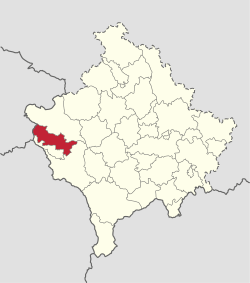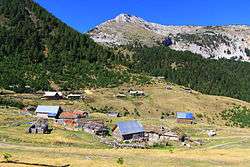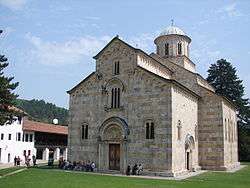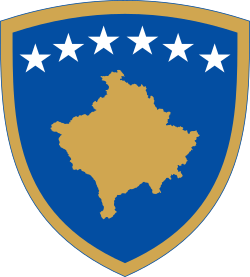Deçan Municipality
| Deçan Municipality | |
|---|---|
| municipality | |
|
Deçan / Deçani Dečani / Дечани | |
 Location of the municipality of Deçan within Kosovo | |
| Coordinates: 42°32′N 20°17′E / 42.533°N 20.283°ECoordinates: 42°32′N 20°17′E / 42.533°N 20.283°E | |
| Country | Kosovo[lower-alpha 1] |
| District | District of Gjakova |
| Government | |
| • Mayor | Bashkim Ramosaj |
| • Municipal | 297 km2 (115 sq mi) |
| Elevation | 550 m (1,800 ft) |
| Population (2011) | |
| • Urban | 3,803 |
| • Municipal | 40,019 |
| • Municipal density | 130/km2 (350/sq mi) |
| Time zone | UTC+1 (CET) |
| • Summer (DST) | UTC+2 (CEST) |
| Postal code | 51000 |
| Area code(s) | +383 390 |
| Car plates | 03 |
| Website |
kk |
Deçan or Dečani (Albanian: Deçan, Deçani; Serbian: Дечани, Dečani, pronounced [dɛ̌t͡ʃani]) is a municipality located in the Gjakova District of Kosovo[lower-alpha 1]. The seat is at Deçan. According to the 2011 census, the town of Deçan has 3,803 inhabitants, while the municipality has 40,019 inhabitants.
It is a mountainous area which borders Montenegro and Albania. There is a total of 36 villages within the municipality. The municipality covers an area of 371 km2.
During the 1998–1999 war, Deçan was one of the strongholds of the Kosovo Liberation Army (KLA) and subsequently suffered a large amount of infrastructure destruction by the Serbian police and paramilitary forces. Much reconstruction has taken place with the assistance of the international agencies and support from the Kosovo Albanian diaspora. It is widely known amongst the Serbian population for the Visoki Dečani monastery of the Serbian Orthodox Church.
Geography
Deçan lies in the Prokletije mountain region. It is surrounded by the Beleg Mountain.
List of settlements

List of settlements:[1]
| Albanian language | Serbo-Croatian language |
|---|---|
| Baballoq | Babaloć |
| Carrabreg i Epërm | Gornji Crnobreg |
| Carrabreg i Poshtem | Donji Crnobreg |
| Drenoc | Drenovce |
| Dubovik | Dubovik |
| Gllogjan | Glođane |
| Gramaçel | Gramočelj |
| Jasiq | Jasić |
| Kodrali | Kodralija |
| Lëbushë | Ljubusa |
| Lloqan | Locan |
| Lumbardh | Bistrica |
| Maznik | Maznik |
| Pobergjë | Pobrđe |
| Papiq | Papić |
| Pepsh | Pepša |
| Pozhar | Požar |
| Prelep | Prilep |
| Rastavica | Rastavica |
| Ratish i Epërm | Gornji Ratiš |
| Irzniq | Rznić |
| Beleg | Beleg |
| Shaptej | Šaptej |
| Sllup | Slup |
| Strellc i Epërm | Gornji Streoc |
| Strellc i Poshtem | Donji Streoc |
| Voksh | Vokša |
| Vranoc i Vogël | Mali Vranovac |
Demographics
| Municipal historical population | ||
|---|---|---|
| Year | Pop. | ±% p.a. |
| 1948 | 20,672 | — |
| 1953 | 22,218 | +1.45% |
| 1961 | 25,582 | +1.78% |
| 1971 | 31,335 | +2.05% |
| 1981 | 40,640 | +2.63% |
| 1991 | 49,000 | +1.89% |
| 2011 | 40,019 | −1.01% |
| 2016 est. | 41,173 | +0.57% |
| Source: Division of Kosovo | ||
According to the 2011 census results, the population of the municipality numbered 40,019 inhabitants. The municipality has ethnic Kosovo Albanians majority, with other minority groups including Bosniaks, Kosovo Ashkalia, Egyptians and Roma. The non-Albanian communities mainly reside in the villages of Babaloq, Dubovik, Gllogjan, Gramaçel, Posar, Rastavica, Shaptej. There are Serbian Orthodox clergy in the Visoki Dečani monastery.
Culture
Visoki Dečani monastery

The Serbian Orthodox monastery Visoki Dečani near the town is 36 meters by 24 meters with a tower 29 meters high. It was built between 1327 and 1335 by the medieval king Stefan Uroš III Dečanski of Serbia, and was dedicated to the Ascension of the Lord. The monastery is situated in the valley of the Dečanska Bistrica river surrounded by the mountains and forests of the Prokletije mountain range. It is regarded as the largest and best preserved medieval monastery in Kosovo. The founding charter of the monastery is dated 1330. The following year the King Stefan Uroš III died and was buried at the monastery, which henceforth became his popular shrine. Indeed, the epithet Dečanski refers to geographical location of the king's foundation of the monastery. Construction was continued by his son Emperor Stefan Uroš IV Dušan until 1335, but the wall-painting was not completed until 1350.
Visoki Dečani was declared a Monument of Culture of Exceptional Importance in 1990, and was protected by the former Federal Republic of Yugoslavia. In 2004, UNESCO listed the monastery on the World Heritage List, citing its frescoes as "one of the most valued examples of the so-called Palaeologan renaissance in Byzantine painting" and "a valuable record of the life in the 14th century" and is protected by UNMIK/KFOR.
During its turbulent history the monastery was an important spiritual center renowned for its artistic and intellectual activities. Although the monastery buildings suffered damage during the Ottoman period, the church has been completely preserved complete with its 14th-century fresco paintings. Today a young brotherhood of 30 brethren lives in the monastery maintaining the traditions of the past: religious services, icon painting, wood carving, book publishing and is also active in the missionary work. The beautiful monastic services are served according to the typicon of Mount Athos.
In 2004, UNESCO listed the monastery on the World Heritage List, citing its frescoes as "one of the most valued examples of the so-called Palaeologan renaissance in Byzantine painting" and "a valuable record of the life in the 14th century". From the exterior, it is also a valued and unusual example of a successful marriage between the early Italian Renaissance and Orthodox styles of architecture.
Notable people
- Aferdita Kameraj, footballer.
- Ramush Haradinaj, former officer and leader of the Kosovo Liberation Army (KLA/UÇK), and the former Prime Minister of Republic of Kosovo.
- Azem Maksutaj, kickboxer.
- Kosta Pećanac, Chetnik commander.
- Valmir Berisha, footballer.
See also
Notes
- 1 2 Kosovo is the subject of a territorial dispute between the Republic of Kosovo and the Republic of Serbia. The Republic of Kosovo unilaterally declared independence on 17 February 2008, but Serbia continues to claim it as part of its own sovereign territory. The two governments began to normalise relations in 2013, as part of the Brussels Agreement. Kosovo has received formal recognition as an independent state from 113 out of 193 United Nations member states.
References
- ↑ "Archived copy". Archived from the original on 2012-07-09. Retrieved 2012-07-09. GNS Name Database
- OSCE Organization for Security and Co-operation in Europe: mik/2005/02/1181_en.pdf
- PTK – Post and Telecommunictions of Kosovo, J.S.C:KodePostare.pdf
- ENKEO Electronic Network of Kosovar Environmental Organization: decani.pdf
- IFLA – International Federation of Library Associations and Institutions: kosorepo.htm#_Toc480784381
External links
| Wikimedia Commons has media related to Dečani. |
